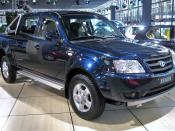Tata motors belongs to the Tata Group. Mr. Tata is the Non-Executive Chairman of the Tata group of companies and Tata Sons. The leadership and guidance to TataÃÂs management and directs is provided by the board of directors and its committees. They also have the power to control and supervise the performance of the Company. The board of directors consists of 8 Non-Executive Directors and 3 Executive Directors. However, more than one third of the total strength of the board is comprised by the 4 independent directors and Mr. Tata.
Advantages of centralizationThere are four main benefits TATA gains from its centralization structure. Firstly, centralization can facilitate coordination for TATA. Secondly, centralization can help ensure that decisions are making by the TATA group and consistent with TATAÃÂs organizational objectives. Thirdly, by concentrating power and authority in the board of directors and committees of TATA group, centralization can give TATAÃÂs top-level managers the means to bring about needed main organizational changes.
Fourthly, centralization can help TATA to avoid the duplication of activities that occurs when similar activities are conducted by various subunits within TATA.
Global matrix structure of TATAÃÂThe worldwide product divisional structure is suitable for diversified firms, it provides a better framework for pursuing location and experience curve economies and for transferring core competencies but it is weak in local responsiveness (Charles. W. L.HILL, 2005, P451)ÃÂ. As a worldwide product divisional structure, Tata commercial vehicles division and passenger vehicles are self- contained. The divisional managers of Tata are more important than the country manager that may cause lower local responsiveness (see Figure 1.0). Therefore, in order to facilitate local responsiveness and provide customer-desired products, Tata moving its organizational structure from a worldwide product divisional structure to global matrix structure (see figure 2.0).
Figure 1.0: A Worldwide Product Divisional Structure...


